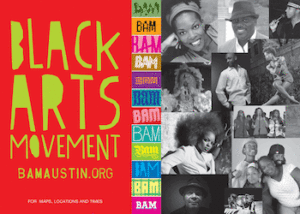
*The Black Arts Movement (BAM) is celebrated on this date in 1965. They were a Black-led art movement active during the 1960s and 1970s.
BAM created new cultural institutions through activism and art and conveyed another message of black pride. The beginnings of the Black Arts Movement focus on when Amiri Baraka moved uptown to establish the Black Arts Repertory Theatre/School. This shift allowed the assassination of Malcolm X. The Black Power movement, the American Civil Rights Movement, and the Black Arts Movement grew out of a changing political and cultural climate. Here, Black artists attempted to create politically engaged work that explored African American cultural and historical experiences.
Black artists and intellectuals such as Baraka made it their project to reject older political, cultural, and artistic traditions. Many Black Arts activists rejected the non-militant integrational ideologies of civil rights and favored those of the Black Liberation Struggle. According to the Academy of American Poets, "African American artists within the movement sought to create politically engaged work that explored the African American cultural and historical experience." The movement's importance on Black autonomy is apparent through creating institutions such as the Black Arts Repertoire Theatre School (BARTS), created in the spring of 1964. Although the creation of BARTS catalyzed the spread of other Black Arts institutions and the Black Arts movement across the nation, it was not solely responsible for the movement's growth.
Although the Black Arts Movement had Black success and artistic progress, the movement also faced social and racial ridicule. The leaders and artists called for Black Art to define itself and speak for itself from the security of its institutions. For many, the idea that somehow black people could express themselves through institutions of their creation, interests, and measures was absurd. The movement began in the Northeast, eventually forming the broader national movement. The geographical diversity of the movement opposes the misconception that New York was the primary site of the movement. In its beginning stages, the movement came together largely through printed media.
journals such as Liberator, The Crusader, and Freedomways created "a national community in which ideology and aesthetics were debated and a wide range of approaches to African-American artistic style and subject displayed." These publications tied communities outside of large Black Arts centers to the movement and gave the general black public access to these sometimes-exclusive circles. Black Arts had its roots in groups such as the Umbra Workshop as a literary movement. Umbra was a collective of young Black writers.
Major members were writers Steve Cannon, Tom Dent, Al Haynes, David Henderson, Calvin C. Hernton, Joe Johnson, Norman Pritchard, Lennox Raphael, Ishmael Reed, Lorenzo Thomas, James Thompson, and Askia M. Touré (Roland Snellings; also a visual artist), Brenda Walcott, and musician-writer Archie Shepp. Umbra produced Umbra Magazine, the first post-civil rights Black literary group to make an impact as radical in establishing their own published voice. The attempt to merge a black-oriented activist thrust with a primarily artistic orientation produced a classic split in Umbra between those who wanted to be activists and those who thought of themselves as primary writers. Moreover, Umbra evolved out of On Guard for Freedom, founded on the Lower East Side by Calvin Hicks.
Its members included Nannie and Walter Bowe, Harold Cruse, Dent, Rosa Guy, Joe Johnson, LeRoi Jones, Sarah E. Wright, and others. On Guard was active in a famous protest at the United Nations of the American-sponsored Bay of Pigs Cuban invasion and supported the Congolese liberation leader Patrice Lumumba. From On Guard, Dent, Johnson, Derek Walcott, Hernton, Henderson, and Touré established Umbra. Famously referred to by Larry Neal as the "aesthetic and spiritual sister of Black Power," BAM applied these same political ideas to art and literature. The movement resisted traditional Western influences and found new ways to present the black experience.
To be a Writer
To Become an Editor
To Become a Desktop Publisher